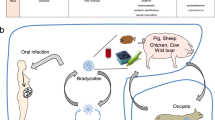Abstract
As an intracellular parasite, Toxoplasma gondii evades direct attack by the humoral immune response. Host defense reactions which efficiently strike the pathogen within the parasitophorous vacuole are cell-mediated and result either in lysis of the host cell or in its activation to inhibit intracellular parasite growth. Several populations of immune cells are crucially involved in both effector pathways: natural killer cells, CD8+ T lymphocytes and CD4+ T cells of the helper 1 (Th1) subtype. Each of these cell types is able to produce interferon-γ(IFN-γ), the prerequisite mediator of protective immunity to T. gondii. IFN-γ triggers antiparasitic activity in macrophages and other cells. The relevance of immune-mediated host cell lysis for the control of acute or chronic infection still needs to be clarified.
Access this chapter
Tax calculation will be finalised at checkout
Purchases are for personal use only
Preview
Unable to display preview. Download preview PDF.
Similar content being viewed by others
References
Aosai F, Yang TH, Ueda M, Yano A (1994) Isolation of naturally processed peptides from a Toxoplasma gondii-infected human B lymphoma cell line that are recognized by cytotoxic T lymphocytes. J Parasitol 80:260–266
Brinkmann V, Remington JS, Sharma SO (1993) Vaccination of mice with the protective F3G3 antigen of Toxoplasma gondii activates CD4+ but not CD8+ T cells and induces Toxoplasma specific IgG antibody. Mol Immunol 30:353–358
Bolow R, Boothroyd JC (1991) Protection of mice from fatal Toxoplasma gondii infection by immunization with P30 antigen in liposomes. J Immunol 147:3496–3500
Chardes T, Velge-Roussel F, Mevelec P, Mevelec MN, Buzoni-Gatel O, Bout O (1993) Mucosal and systemic cellular immune responses induced by Toxoplasma gondii antigens in cyst orally infected mice. Immunol 78:421–429
Curiel TJ, Krug EC, Purner MB, Poignard P, Berens RL (1993) Cloned human CD4+ cytotoxic T lymphocytes specific for Toxoplasma gondii lyse tachyzoite-infected target cells. J Immunol 151:2024–2031
Darcy F, Maes P, Gras-Masse H, Auriault C, Bossus M, Deslee D, Godard I, Cesbron MF, Tartar A, Capron A (1992) Protection of mice and nude rats against toxoplasmosis by a multiple antigenic peptide construction derived from Toxoplasma gondii P30 antigen. J Immunol 149: 3636–3641
Denkers EY, Caspar P, Sher A (1994) Toxoplasma gondii possesses a superantigen activity that selectively expands murine T cell receptor Vß5-bearing CD8+ lymphocytes. J Exp Med 180:985–994
Duquesne V, Auriault C, Gras-Masse H, Boutillon C, Darcy F, Cesbron-Delauw MF, Tartar A, Capron A (1991) Identification of T cell epitopes within a 23-kDa antigen (P24) of Toxoplasma gondii. Clin Exp Immunol 84:527–534
Godard I, Estaquier J, Zenner L, Bossus M, Auriault C, Darcy F, Gras-Masse H, Capron A (1994) Antigenicity and immunogenicity of P30-derived peptides in experimental models of toxoplasmosis. Mol Immunol 31:1353–1363
Guile H, Schoel B, Kaufmann SHE (1990) Direct blotting with viable cells of protein mixtures separated by two-dimensional gel electrophoresis. J Immunol Meth 133:253–261
Henion P, Hernandez-Pando R, Dubremetz JF, Saavedra R (1993) Subcellular localization of the 54-kDa antigen of Toxoplasma gondii. J Parasitol 79:216–222
Kasper LH, Currie KM, Bradley MS (1985) An unexpected response to vaccination with a purified major membrane tachyzoite antigen (P30) of Toxoplasma gondii. J Immunol 134:3426–3431
Kasper LH, Khan IA, Ely KH, Bulow R, Boothroyd JC (1992) Antigen-specific (P30) mouse C08+ T cells are cytotoxic against Toxoplasma gondii-infected peritoneal macrophages. J Immunol 148: 1493–1498
Khan IA, Eckel ME, Pfefferkorn ER, Kasper LH (1988) Production of y interferon by cultured human lymphocytes stimulated with a purified membrane protein (P30) from Toxoplasma gondii. J Infect Dis 157:979–984
Khan IA, Ely KH, Kasper LH (1991) A purified parasite antigen (P30) mediates C08+ T cell immunity against fatal Toxoplasma gondii infection in mice. J Immunol 147:3501–3506
Khan IA, Ely KH, Kasper LH (1994) Antigen-specific C08+ T cell clone protects against acute Toxoplasma gondii infection in mice. J Immunol 152:1856–1860
Mougneau E, Altare F, Wakil AE, Zheng S, Coppola T, Wang ZE, Waldmann R, Locksley RM, Glaichenhaus N (1995) Expression cloning of a protective Leishmania antigen. Science 268:563–566
Parmley SF, Gross U, Sucharczuk A, Windeck T, Sgarlato GO, Remington JS (1994) Two alleles of the gene encoding surface antigen P22 in 25 strains of Toxoplasma gondii. J Parasitol 80:293–301
Prigione I, Facchetti P, Ghiotto F, Tasso P, Pistoia V (1995) Toxoplasma gondii-specific C04+ T cell clones from healthy, latently infected humans display a ThO profile of cytokine secretion. Eur J Immunol 25:1298–1305
Saavedra R, Herion P (1991) Human T-cell clones against Toxoplasma gondii: production of interferon-y, interleukin-2, and strain cross-reactivity. Parasitol Res 77:379–385
Saavedra R, de Meuter F, Decourt JL, Herion P (1991) Human T cell clone identifies a potentially protective 54-kOa protein antigen of Toxoplasma gondii cloned and expressed in Escherichia coli. J Immunol 147:1975–1982
Saavedra R, Becerril MA, Oubeaux C, Lippens R, Herion R, Bollen A (1995) Identification of T-cell epitopes in the ROP2 protein antigen of Toxoplasma gondii. 9th International Congress of Immunology, 23–29 July 1995, San Francisco, p 347 (abstract)
Sharma SO, Araujo FG, Remington JS (1984) Toxoplasma antigen isolated by affinity chromatography with monoclonal antibody protects mice against lethal infection with Toxoplama gondii. J Immunol 13: 2818–2820
Author information
Authors and Affiliations
Editor information
Editors and Affiliations
Rights and permissions
Copyright information
© 1996 Springer-Verlag Berlin Heidelberg
About this chapter
Cite this chapter
Fischer, H.G., Reichmann, G., Hadding, U. (1996). Toxoplasma Proteins Recognized by Protective T Lymphocytes. In: Gross, U. (eds) Toxoplasma gondii. Current Topics in Microbiology and Immunology, vol 219. Springer, Berlin, Heidelberg. https://doi.org/10.1007/978-3-642-51014-4_16
Download citation
DOI: https://doi.org/10.1007/978-3-642-51014-4_16
Publisher Name: Springer, Berlin, Heidelberg
Print ISBN: 978-3-642-51016-8
Online ISBN: 978-3-642-51014-4
eBook Packages: Springer Book Archive




